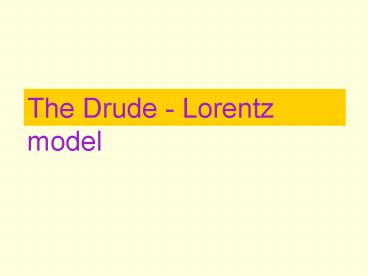Prsentation PowerPoint PowerPoint PPT Presentation
1 / 12
Title: Prsentation PowerPoint
1
The Drude - Lorentz model
2
w0
-
In the Drude - Lorentz model, one assumes that
the electrons are harmonically bound to their
equilibrium positions.
Negligible if v ltltc
Restoring force
damping
3
A few examples Impurity states in semiconductor
and insulators. An electron (a hole) is bound to
a positively (negatively) charged
center. Resonant frequency in the far
IR(semiconductor) to near IR (insulator). Optical
vibrations (phonons) Delocalized excitation
over the crystal. Resonant frequency in the
far/middle IR in semiconductors / insulators.
4
The variations of the electric field of the wave
over the electron motion are negligible l 1mm
d ? 0.5 nm. Thus, in the permanent regime where
the electronic motion is forced by the e-m field
?
The dipoles are uniformly distributed
w dependent conductivity
If several wn
? w dependent dielectric constant eel(w)
5
Let us consider one site Ri around which the ith
electron is vibrating. We write In the forced
regime To the extent that q.riltlt1, we get a
microscopic current that is proportional to the
local field at Ri.The proportionality coefficient
is independent of Ri. Hence, by considering a
volume a3ltlt v ltlt l3, we shall get a mesoscopic
current that is also proportional to the average
field in this volume and also to the
concentration of dipoles in v.
6
Hence Re?(?) - 1 is even in ? while Im?(?) is
an odd function of ?. In the limit of vanishing a
It can be shown that ???? e1 ie2 is an
analytic function of the complex variable ?.
This implies that the real and imaginary parts of
???? are integral transforms of one another
(Kramers -Kronig)
Thus, only the knowledge of e1 or e2 is
necessary. In practice, since only a finite w
segment can be explored, one has to make guesses
(about the large w behaviours)? Fast Fourier
Transform.
7
Drude - Lorentz results for a single resonance
frequency
When w ?? the material system cannot respond it
behaves like vacuum.
forbidden propagation (n lt 0)
In dilute media (gases) w1 differs very little
from w0. In dense media (solids), w1 can differ
substantially from w0. However, in solids, one
meets bands of wn rather than a single w0.
8
The Drude - Lorentz model for heterostructures In
heterostructures the dipoles coupled to the light
are not uniformly distributed. How to
generalize Drude - Lorentz?
z
Other (non resonant) dipoles
Volume density of active dipoles
9
1D Schrödinger equation
10
Continuity conditions at z 0
If w ? w0
11
R T ? 1 !! Due to dissipation (a ? 0)! Pabs
1 - R - T
12
For a typical density of quantum dots in a single
plane N/S 1010cm-2 and ? 10-11s, m 0.1m0,
n 3.5, the absorption probability at resonance
(? ?0) is ? 3. The low absorption probability
also implies that observable effects may require
the use of multiple planes of dots.

